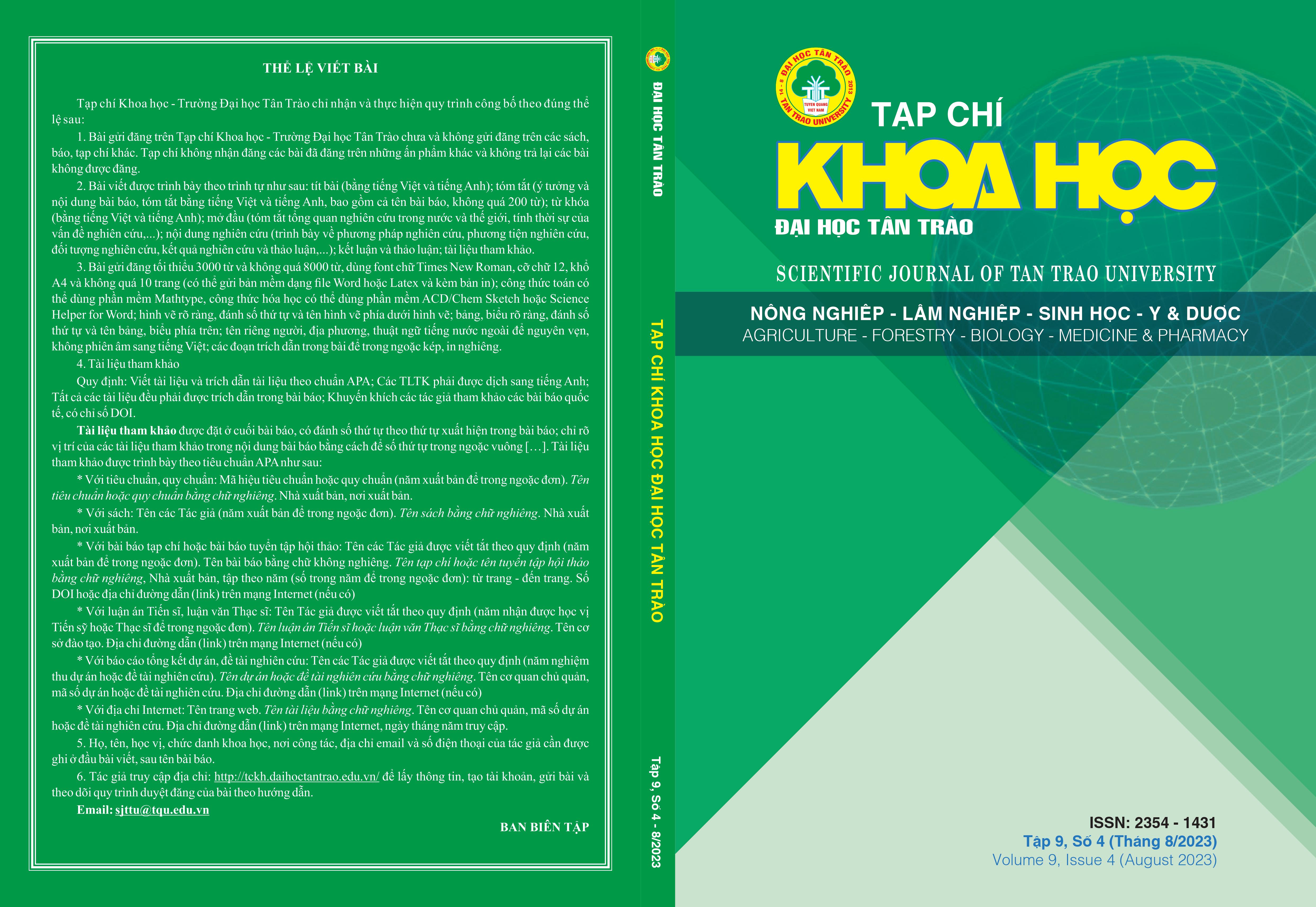ATTITUDE AND PERCEPTION OF LOCAL FARMERS TOWARD AGROBIODIVERSITY IN HOME GARDEN. CASE STUDY: BUOT VILLAGE, CHIENG YEN COMMUNE, VAN HO DISTRICT, SON LA PROVINCE, VIETNAM
DOI:
https://doi.org/10.51453/2354-1431/2023/855Keywords:
Food forest, syntropic farming, garden productivity, environmental benefits, sustainable agricultureAbstract
One of today’s key challenges is how to increase production to meet the growing demand for food, feed, and bioenergy while conserving biodiversity and reducing the pressure on natural resources and ecosystems. Agrobiodiversity is not only the key to food security and nutrition but also to conserving the ecosystem foundations necessary (e.g. of water quality, nutrient cycling, soil formation and rehabilitation, erosion control, carbon sequestration) to sustain life and rural livelihoods. This study examined the perception of farmers on agrobiodiversity and the factors behind the farmers' decision to adopt agrobiodiversity through applying syntrophic farming (food forest) in their home gardens. A semi-structured interview approach was used to gather information from 39 local farmers in Buot village, Son La province, Vietnam. The survey found that 14 households of the total households have been adopting agrobiodiversity. Most of the farmers asked understood the importance of agrobiodiversity and were willing to adopt syntrophic farming. However, challenges in capital, market access, and no irrigation systems are barriers that hinder their adoption of syntrophic farming. The findings of the study will provide information for policy-makers in providing enabling conditions to facilitate agrobiodiversity in the study area.
Downloads
References
[1] Bellon, M.R., van Etten, J. 2014. Climate change and on-farm conservation of crop landraces in centres of diversity. In Plant Genetic Resources and Climate Change, pp. 137-150.
[2] Beaumelle, L., Auriol, A., Grasset, M., Pavy, A., Thiéry, D., & Rusch, A. (2021). Benefits of increased cover crop diversity for predators and biological pest control depend on the landscape context. Ecological Solutions and Evidence, 2(3), e12086.
[3] Braun, V., & Clarke, V. (2006). Using thematic analysis in psychology. Qualitative Research in Psychology, 3(2), 77–101. https://doi.org/10.1191/1478088706qp063oa.
[4] Food and Agriculture Organization of the United Nations. Agroforestry Definition,https://www.fao.org/forestry/agroforestry/80338/en/, accessed December 27, 2022.
[5] FAO. (1999a). Agricultural Biodiversity, Multifunctional Character of Agriculture and Land Conference, Background Paper 1. Maastricht, Netherlands. September 1999.
[6] Food and Agriculture Organization of the United Nations. Agroforestry, https://www.fao.org/forestry/agroforestry/en/, accessed December 27, 2022.
[7] Galhena, D. H., Freed, R., & Maredia, K. M. (2013). Home gardens: a promisingapproach to enhance household food security and wellbeing. Agriculture & food security, 2(1), 1-13.
[8] Google. (n.d.). Google Maps of Buot Village Location,https://goo.gl/maps/ggSPTWnxyR6VDq62A, accessed December 19, 2022
[9] Hillbrand, A., Borelli, S., Conigliaro, M., & Olivier, E. (2017). Agroforestry for landscape restoration: exploring the potential of agroforestry to enhance the sustainability and resilience of degraded landscapes.FAO.
[10] Lockheed, M. E., Jamison, T., & Lau, L. J. (1980). Farmer education and farm efficiency: A survey. Economic Development and Cultural Change, 29(1), 37-76.
[11] Luke, J., McIlveen, P., & Perera, H.N. (2016) A thematic analysis of career adaptability in retirees who return to work. Frontiers in Psychology 7:193. doi: 10.3389/fpsyg.2016.00193
[12] Mengistu, M., & Fitamo, D. (2015). Role and problems of coffee and enset dominant home gardens for enhanced livelihood and food security in Dilla district, southern Ethiopia. East African Journal of Sciences, 9(2), 131-140.
[13] Queensland Government. Soil fertility decline, www.qld.gov. au/environment/land/soil/soil-health/fertility-decline, accessed on January 12, 2023.
[14] Noosaforestretreat. Whats The Difference Between Syntropic Farming And Permaculture, https://noosaforestretreat.com/whats-the-difference-between-syntropic-farming-and-permaculture/, accessed on December 27, 2022.
[15] Staal, S. (2014) A situational analysis of agricultural production and marketing, and natural resources management systems in northwest Vietnam. International Livestock Research Institute for CGIAR Research Program, Nairobi
[16] Strauss, J., Barbosa, M., Teixeira, S., Thomas, D., & Junior, R. G. (1991). Role of education and extension in the adoption of technology: a study of upland rice and soybean farmers in Central-West Brazil. Agricultural Economics, 5(4), 341-359.
[17] Trinh, L. N., Watson, J. W., Hue, N. N., De, N. N., Minh, N. V., Chu, P., ... & Eyzaguirre, P. B. (2003). Agrobiodiversity conservation and development in Vietnamese home gardens. Agriculture, Ecosystems & Environment, 97(1-3), 317-344.
[18] Van Ho Agriculture Sector. (2015). Summary report in 2014. Vietnam Government (Unpublished).
Downloads
Published
How to Cite
Issue
Section
License

This work is licensed under a Creative Commons Attribution-ShareAlike 4.0 International License.
All articles published in SJTTU are licensed under a Creative Commons Attribution-ShareAlike 4.0 International (CC BY-SA) license. This means anyone is free to copy, transform, or redistribute articles for any lawful purpose in any medium, provided they give appropriate attribution to the original author(s) and SJTTU, link to the license, indicate if changes were made, and redistribute any derivative work under the same license.
Copyright on articles is retained by the respective author(s), without restrictions. A non-exclusive license is granted to SJTTU to publish the article and identify itself as its original publisher, along with the commercial right to include the article in a hardcopy issue for sale to libraries and individuals.
Although the conditions of the CC BY-SA license don't apply to authors (as the copyright holder of your article, you have no restrictions on your rights), by submitting to SJTTU, authors recognize the rights of readers, and must grant any third party the right to use their article to the extent provided by the license.


